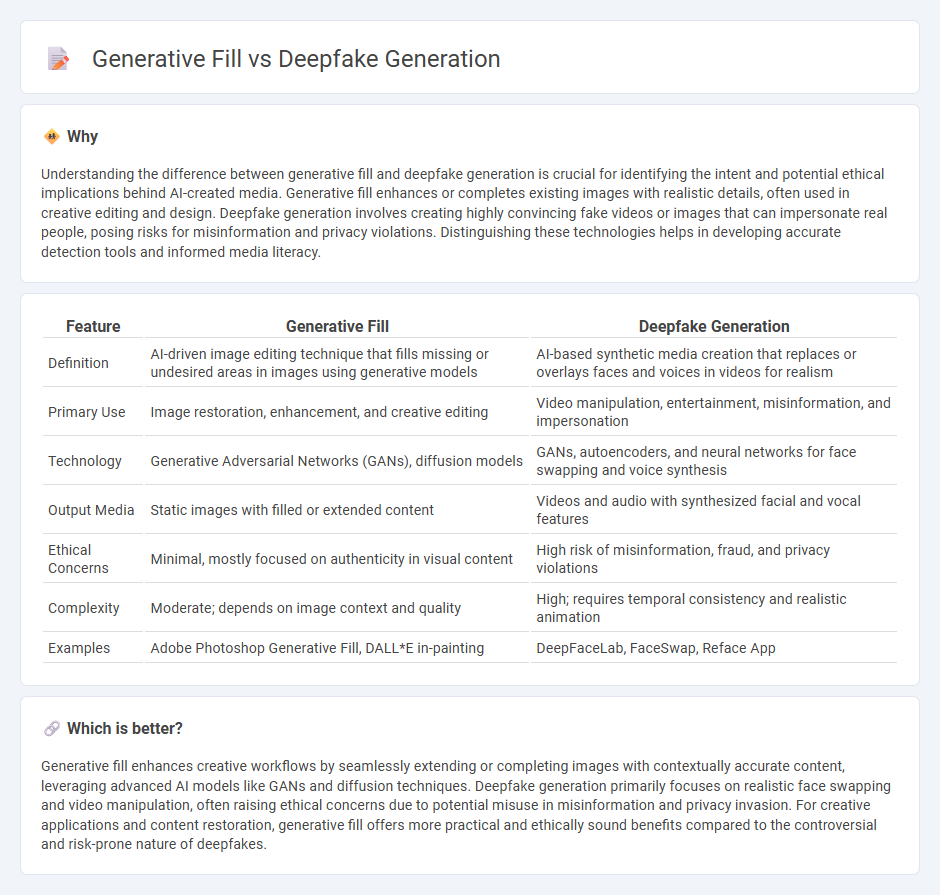
Generative fill utilizes advanced AI algorithms to seamlessly complete or expand images and videos by predicting missing content based on contextual data. Deepfake generation leverages deep learning models to create hyper-realistic manipulations of audio-visual content, often replicating human appearances and voices with high precision. Explore how these transformative technologies are reshaping digital creativity and authenticity.
Why it is important
Understanding the difference between generative fill and deepfake generation is crucial for identifying the intent and potential ethical implications behind AI-created media. Generative fill enhances or completes existing images with realistic details, often used in creative editing and design. Deepfake generation involves creating highly convincing fake videos or images that can impersonate real people, posing risks for misinformation and privacy violations. Distinguishing these technologies helps in developing accurate detection tools and informed media literacy.
Comparison Table
| Feature | Generative Fill | Deepfake Generation |
|---|---|---|
| Definition | AI-driven image editing technique that fills missing or undesired areas in images using generative models | AI-based synthetic media creation that replaces or overlays faces and voices in videos for realism |
| Primary Use | Image restoration, enhancement, and creative editing | Video manipulation, entertainment, misinformation, and impersonation |
| Technology | Generative Adversarial Networks (GANs), diffusion models | GANs, autoencoders, and neural networks for face swapping and voice synthesis |
| Output Media | Static images with filled or extended content | Videos and audio with synthesized facial and vocal features |
| Ethical Concerns | Minimal, mostly focused on authenticity in visual content | High risk of misinformation, fraud, and privacy violations |
| Complexity | Moderate; depends on image context and quality | High; requires temporal consistency and realistic animation |
| Examples | Adobe Photoshop Generative Fill, DALL*E in-painting | DeepFaceLab, FaceSwap, Reface App |
Which is better?
Generative fill enhances creative workflows by seamlessly extending or completing images with contextually accurate content, leveraging advanced AI models like GANs and diffusion techniques. Deepfake generation primarily focuses on realistic face swapping and video manipulation, often raising ethical concerns due to potential misuse in misinformation and privacy invasion. For creative applications and content restoration, generative fill offers more practical and ethically sound benefits compared to the controversial and risk-prone nature of deepfakes.
Connection
Generative fill and deepfake generation both utilize advanced generative adversarial networks (GANs) to create realistic synthetic content by analyzing and replicating data patterns. These technologies rely on deep learning algorithms to manipulate images, videos, or audio, enabling seamless alterations or creations that challenge authenticity detection. Their shared foundation in AI-driven content synthesis highlights significant implications for media, security, and digital ethics.
Key Terms
**Deepfake Generation:**
Deepfake generation utilizes advanced AI algorithms and deep neural networks to create hyper-realistic video and audio manipulations, often replacing one person's likeness or voice with another's in a seamless manner. This technology leverages generative adversarial networks (GANs) and facial reenactment models to produce convincing forgeries that have significant implications in entertainment, security, and misinformation. Explore the nuances, ethical considerations, and latest advancements in deepfake generation to understand its impact fully.
Face Swapping
Face swapping technology in deepfake generation utilizes advanced neural networks to create highly realistic facial replacements by analyzing facial landmarks and texture mapping. Generative fill methods enhance this process by using AI-driven image inpainting to seamlessly blend swapped faces into backgrounds, improving visual coherence and reducing artifacts. Explore the latest advancements in face swapping techniques to understand their applications and implications in digital media.
GANs (Generative Adversarial Networks)
Deepfake generation relies heavily on GANs to create hyper-realistic synthetic videos by pitting generator and discriminator networks against each other until the fake content is indistinguishable from real footage. Generative fill, also powered by GANs, focuses on image inpainting to seamlessly replace or fill missing parts of images using learned contextual data and patterns. Explore the nuances of how GAN architectures optimize these distinct applications and their impact on digital media authenticity.
Source and External Links
A Framework for Detection in an Era of Rising Deepfakes - This article discusses the evolution of deepfakes and their implications, explaining how they are generated using deep neural networks to create realistic images or videos.
Deepfakes Web - This platform allows users to create deepfake videos by uploading images and videos, using cloud-based AI to swap faces within minutes.
Awesome-Deepfake-Generation-and-Detection - This GitHub repository provides a detailed survey of deepfake generation and detection methods, including face swapping and reenactment techniques.
 dowidth.com
dowidth.com